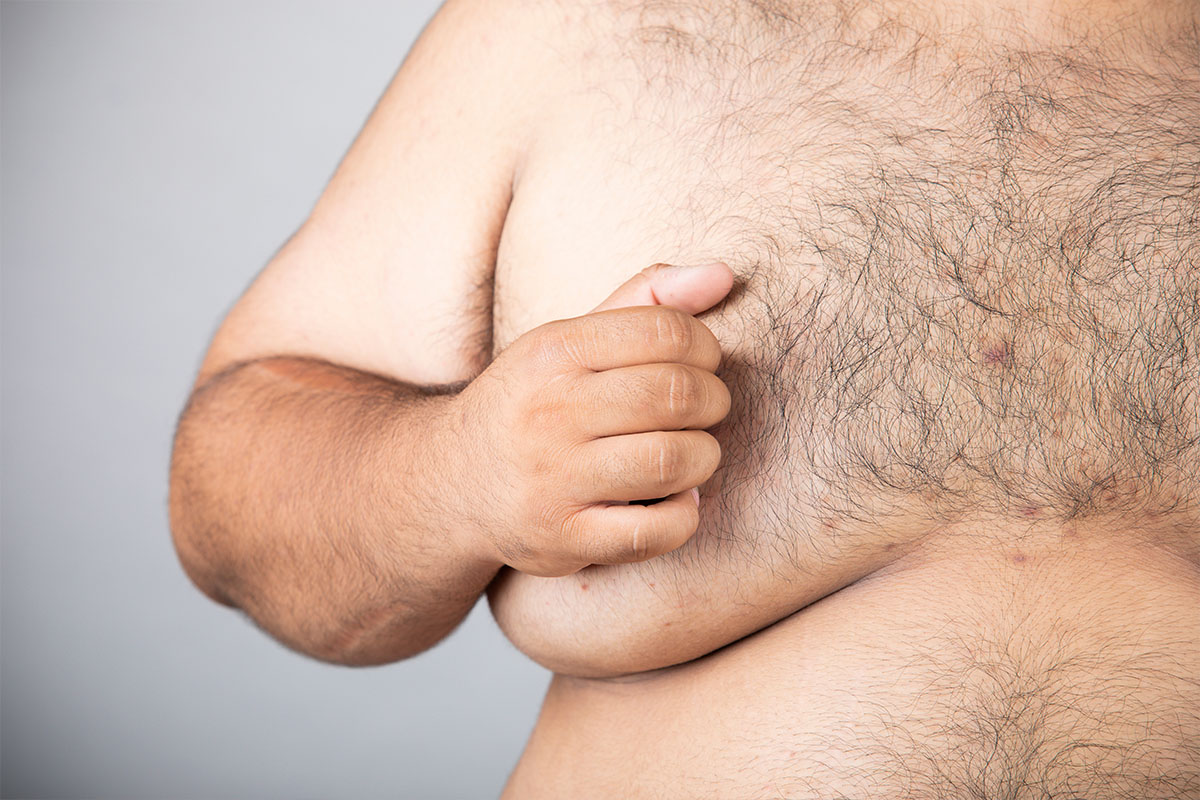
Are you aware of the subtle but critical differences between gynecomastia and pseudogynecomastia? These conditions, often misused interchangeably, have distinct characteristics and root causes. This article takes a deep dive into understanding gynecomastia and pseudogynecomastia, their symptoms, and how one can distinguish between the two. Knowledge is your first step toward a healthier and more confident self, so read on!
Learn about Gynecomastia and Pseudogynecomastia.
Gynecomastia and pseudogynecomastia are conditions affecting men’s chests. Gynecomastia involves the swelling of breast tissue due to hormonal imbalance. On the other hand, pseudogynecomastia happens due to excessive fat deposits unrelated to hormone imbalance. While similar in appearance, these conditions differ in their origin and management.
The differences between gynecomastia and pseudogynecomastia largely revolve around the cause and substance causing chest enlargement. By understanding these unique traits, we can tailor treatment plans that consider our bodies’ specific conditions. However, a professional diagnosis is crucial to differentiate between these conditions accurately. No bullet list or table is required for this section.
Gynecomastia: A Closer Look
Gynecomastia is a condition characterized by an enlargement of the glandular breast tissue in males. At its core, it involves an imbalance of key hormones- estrogen and testosterone. The breast swells, typically affecting both sides equally, and can feel tender around the nipple.
In true gynecomastia, glandular breast tissue is present. Increased estrogen or decreased testosterone concentrations lead to this. It is also seen as a side effect of kidney disease, as kidneys help regulate hormone levels. The skin around the breast might tighten, leaving a stretched appearance.
Various factors contribute to changes in hormone levels that might trigger gynecomastia. Conditions affecting the testes or pituitary gland and consumption of certain medications can upset the estrogen-testosterone balance. True gynecomastia isn’t a serious problem, but it can be tough to cope with the condition.
Treatment of gynecomastia depends on the individual, the cause, and the severity of the condition. Healthy lifestyle changes are often the first step in treatment. It’s also equally important to monitor changes in the skin texture and the size of the breast to understand the progress effectively.
As we delve deeper into the condition, we uncover a complex interaction of hormones, genetics, and environmental factors that contribute to gynecomastia. Any severe or persistent symptoms should always be checked by a healthcare provider.
Pseudogynecomastia: An Overview
Pseudogynecomastia is a condition where males develop an excess of fat in their chest area, giving the appearance of breasts. Unlike gynecomastia, which is due to an overgrowth of breast tissue, pseudogynecomastia is solely attributable to weight gain and fat accumulation that tends to localize around the chest.
This excess fat can mimic the look of breasts, leading to a misconception that one has gynecomastia. The skin overlying the areas of fat accumulation tends to be softer and less firm, differing from true gynecomastia, where the underlying breast tissue results in firm, glandular convexities.
When men put on weight, their bodies decide where the additional fat will be stored. In many cases, fat is deposited around the chest muscles, leading to pseudogynecomastia. It can occur in men of all ages and is usually linked to overall obesity.
Skin elasticity also plays a significant role in the appearance of the condition. As people gain weight, their skin stretches to accommodate the increased fat. If weight loss occurs, the skin may not completely revert to its pre-weight gain state, contributing to the perception of excess breast tissue.
From a visual perspective, it may be challenging to distinguish between gynecomastia and pseudogynecomastia. However, understanding the nature of these conditions, their cause, and how they present can assist in identifying the appropriate treatment strategies.
Symptoms and Causes of Gynecomastia and Pseudogynecomastia
Symptoms and Causes of Gynecomastia
Gynecomastia symptoms are typically characterized by the growth of a lump or excess skin in the chest area, specifically under the nipple. You may experience tenderness, discomfort, or even a slight discharge from the nipples. If such symptoms persist, you ought to seek immediate medical assistance.
This condition is primarily linked to hormonal fluctuations, particularly an imbalance between testosterone and other hormones. A decrease in testosterone levels or an increment of other hormones, such as estrogen, can trigger the growth of breast tissue in men.
Several medical conditions may contribute to gynecomastia, including kidney disease or failure, liver disease, and obesity. Aging, too, can cause a hormonal imbalance, which may lead to Gynecomastia. Hospitalization and the use of certain medications have also been reported to cause this condition. Avoiding triggers where possible and maintaining a balanced diet may help prevent this condition.
Pseudogynecomastia Symptoms and Causes
Pseudogynecomastia is marked by enlarging breast tissue, but the similarity with gynecomastia ends there. The main symptom is the chest’s fatty buildup, which tends to get more noticeable with weight gain. The physical appearance may mimic gynecomastia, but instead of glandular tissue, this condition is caused by excessive fat accumulation around the nipple area.
The primary cause of this condition is simple – obesity. The more overweight you are, the higher your chances of developing pseudogynecomastia. Your diet plays a crucial role in this. A diet high in fats and sugars can catalyze weight gain, which can directly lead to pseudogynecomastia.
In rare cases, drugs, like steroids, can induce this condition. They cause an imbalance in hormone levels, leading to abnormal fat build-up in the chest. But remember, the majority of pseudogynecomastia cases are traced back to weight gain. So weight loss through a healthy diet and exercise is often the most effective treatment strategy.
Gynecomastia vs Pseudogynecomastia: Similarities
Gynecomastia and Pseudogynecomastia are often mistaken for each other due to their primary symptom: breast enlargement. In both cases, the chests of affected individuals take on a shape similar to female breasts, leading to a great deal of confusion. This transition occurs due to an accumulation of fatty tissues in the chest area.
The enlargement of the male breasts, in both pseudogynecomastia and gynecomastia, can be either unilateral, affecting only one breast, or bilateral, affecting both breasts. Despite the stark differences in underlying causes, these conditions may coexist, further complicating identification and treatment.
While the prominence of estrogen plays a significant role in gynecomastia, it doesn’t contribute to pseudogynecomastia. However, an increase in body fat can indirectly increase estrogen levels, which can lead to gynecomastia.
Gynecomastia
- Breast Enlargement
- Prominence of Estrogen
- Presence of glandular breast tissue
Pseudogynecomastia
- Breast Enlargement
- No Role of Estrogen
- Absence of glandular breast tissue
Distinguishing Gynecomastia from Pseudogynecomastia
The primary difference between gynecomastia and pseudogynecomastia hinges on the type of tissue causing breast enlargement. In men affected by gynecomastia, a significant amount of glandular tissue is present. This condition results from hormonal alterations that cause an overgrowth of glandular tissue. In contrast, pseudogynecomastia is typically linked to an accumulation of fatty tissue.
Weight gain results in an expanded fatty tissue matrix in the chest region, creating an appearance akin to gynecomastia. However, in this case, the increase is caused by an increase in fat tissues, not glandular ones. The key to distinguishing these conditions lies in the texture of the excess tissue. Glandular tissue feels firm compared to the soft consistency of fat.
Nonetheless, it’s sometimes challenging to distinguish between these conditions since obese men may display both fat increase and gynecomastia. Therefore, breast reduction surgery might be advised in such cases.
Gynecomastia
- Presence of significant glandular tissue
- A condition resulting from hormonal changes
- Consistency of tissue is firm
- Might require a breast reduction procedure
Pseudogynecomastia
- Presence of excess fatty tissue
- A condition resulting from weight gain
- Consistency of tissue is soft
- Might require weight loss
Diagnostic Procedures for Gynecomastia and Pseudogynecomastia
To differentiate between gynecomastia and pseudogynecomastia, doctors use several diagnostic procedures. This usually begins with a comprehensive medical evaluation which includes physical and hormone tests. Doctors may opt for a mammogram or ultrasound to confirm the diagnosis. Biopsies are rarely performed but can be essential when other procedures don’t provide conclusive results.
Doctors often examine breast fat distribution to differentiate the two conditions. In gynecomastia, the enlarged breast tends to be firm because of increased glandular tissue. Pseudogynecomastia, on the other hand, has a more soft and fatty texture due to the accumulation of adipose tissue. Accurate diagnosis is crucial in determining the right treatment approach for both conditions.
Dealing with Gynecomastia and Pseudogynecomastia
Both Gynecomastia and Pseudogynecomastia may affect self-esteem and confidence, but fortunately, there are effective treatment options. Gynecomastia is often linked to hormonal imbalances, and specialized medications can help restore equilibrium. On the other hand, Pseudogynecomastia is attributed to excess fat accumulation, usually managed through changes in diet and regular exercise.
For both conditions, if non-invasive methods are unsuccessful, surgical intervention is available. These procedures are performed by skilled cosmetic surgeons and can dramatically improve physical appearance and self-confidence. It’s recommended to consult with specialist plastic surgeons to understand all available treatment options.
Ultimately, effectively dealing with these conditions depends on understanding their underlying causes and choosing appropriate interventions. Whether the issue is hormonal or related to fat accumulation, progress is certainly possible. Don’t hesitate to seek professional help, consult plastic surgeons or endocrinologists to tackle these conditions efficiently.
Importance of Hormonal Balance in Managing These Conditions
The hormonal balance, particularly the production of testosterone, plays a crucial role in managing conditions like Gynecomastia and Pseudogynecomastia. Testosterone regulates fat distribution and muscle growth in males, factors implicated in these disorders. When hormonal balances alter, conditions like Gynecomastia, characterized by enlarged male breast tissue due to hormonal changes, can develop. Pseudogynecomastia, on the other hand, is not due to hormonal imbalance but results from an increase in fat, often mistaken for Gynecomastia. Therefore, maintaining hormonal balance is vital as it significantly impacts the therapy choice and condition progression.


SPECIALIST CARE YOU CAN TRUST
Dr. Salloum is supported by a brilliant team of caring staff members.
You can trust the entire staff to help make your visit as comfortable and safe as possible!
Risks and Prevention
The potential health risks of gynecomastia and pseudogynecomastia extend beyond physical discomfort and self-consciousness. Health issues can arise due to these conditions, such as hormonal imbalance and related diseases. Substance abuse, like alcohol consumption and using street drugs, or steroids, escalates these issues. To prevent this, limit alcohol and avoid illegal substances. Regular check-ups can help in early detection and treatment.
Avoiding these risks creates a healthier body image and mind, preventing conditions associated with these issues. Adequate knowledge and a proactive, health-conscious lifestyle are strong defense lines against these conditions’ negative effects.
Concluding Thoughts on Understanding Gynecomastia and Pseudogynecomastia
Understanding Gynecomastia and Pseudogynecomastia plays a crucial role in diagnosing and managing these conditions. While both conditions result in enlarged male chests, it’s important to note that the cause and treatment options for each differ significantly.
Gynecomastia stems from hormonal imbalances, and treatments primarily center on hormone therapy or surgery. On the other hand, Pseudogynecomastia results from fat accumulation rather than glandular tissue enlargement. Consequently, a change in diet and regular exercise are essential for its management.
Awareness of these differences ensures that appropriate and effective treatment options are sought, reducing the psychological impacts often linked with these conditions. Remember, the journey to recovery begins with understanding.
Navigating the complex world of medical conditions can be daunting, that’s why it is crucial to consult with a trusted professional when dealing with health concerns such as gynecomastia and pseudogynecomastia. Board-certified plastic surgeon Dr. Gabe Salloum possesses profound expertise in these areas and can assist in offering tailored medical advice and solutions. Allow Dr. Salloum to guide you through the process – call today and book a consultation appointment.